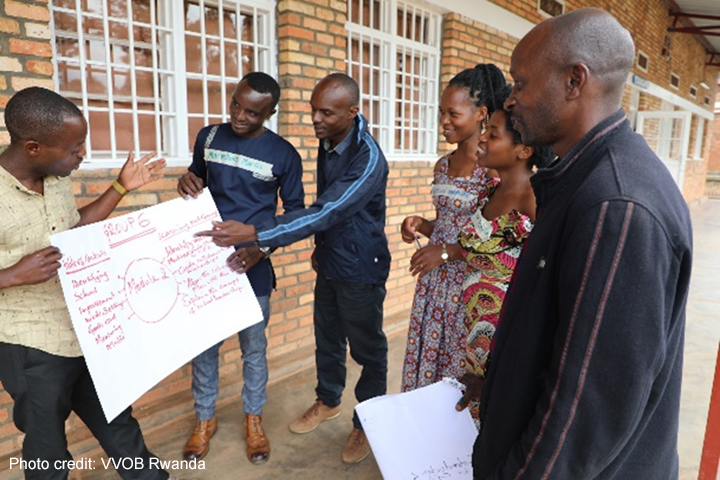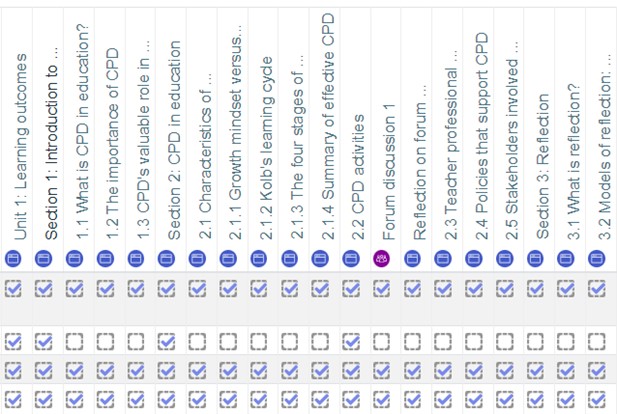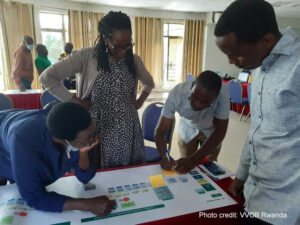This article was written by Loran Pieck, Strategic Education Advisor, VVOB Rwanda and Lieve Leroy, Strategic Education Advisor, VVOB Rwanda.
Introduction and background
“Our generation has no excuse to adopt technology in education. We need to invest in technology so that those who come after us will benefit from this.” This is what one of the lecturers from the University of Rwanda – College of Education (UR-CE) mentioned when reflecting on blended learning.
Rwanda has been leading the way in digital transformation in education. A variety of policies exist which emphasise the use of ICTs in education to improve quality in teaching, learning and research, and consequently in continuous professional development (CPD).
Rwanda Basic Education Board (REB), in collaboration with UR-CE and VVOB – education for development provide accredited CPD programmes for teachers and school leaders. Spurred by the COVID-19 pandemic, these CPD programmes are delivered in a blended modality, with the use of technology. The delivery method of these programmes is based on a thoughtful fusion of online and in-person learning activities connected by bridging activities. This combination allows for a staggered learning approach based on the flipped classroom.
Each CPD programme starts with an in-person session to introduce participants to the purpose and delivery approach of the programme (see Figure 1). Moreover, such in-person sessions offer the opportunity to build relationships. After these introductory in-person sessions, teachers and school leaders engage in interactive online course content. In this component, participants gain new knowledge and understanding of the topics of the CPD programme through interactive, authentic and memorable course content.
Throughout the online course, bridging activities are introduced. Such bridging activities offer participants the opportunity to start reflecting on the content of the course and to translate the content into their own work practice. After the online component, participants go to an in-person session in their districts to practice the content with their peers and to deepen their learning about the content of the course. Whereas the online course focuses on knowledge and comprehension, these in-person sessions are competence-based and focus on acquiring skills. At the end, participants submit an assignment and e-portfolio in which they analyse the content, apply it to their work practice, and create an output which illustrates their learning.
Twice during the programme, a support visit is organised to participants’ schools. The first visit is a coaching and support visit to help participants implement their learning in their daily activities. The second visit is organised towards the end of the programme to assess the application of competences acquired.
The steps taken in blended learning correspond with the different levels in Bloom’s taxonomy (2001). The taxonomy offers a hierarchical classification of various levels of thinking when developing course objectives. These levels are all lying along a continuum from simple to complex and concrete to abstract: remember, understand, apply, analyse, evaluate and create. The staggered learning approach culminates into the assignments while creating multiple opportunities for feedback and adjustments.
Onboarding participants in blended learning
This thoughtful instructional design to deliver blended CPD programmes enhances the learning experience for teachers and school leaders. However, for many of them, it is the first time to participate in an online course. This new mode of learning demands digital literacy skills and self-regulated learning strategies such as time management, effort regulation and critical thinking. If not carefully addressed, these requirements can lead to drop out during the online component of the blended CPD programme. To anticipate these potential challenges, all teachers and school leaders participate in a blended learning onboarding course prior to the start of the CPD programme.
Next, it is known that first-time online learners express the need for a more visible teacher presence in the online course to ease their adjustment to the online environment. Many online learners prefer to have their learning sequenced and directed through the assistance of a teacher or trainer. The trainer role is shifting from a traditional purveyor of knowledge, commonly used in in-person sessions, to a facilitator of learning. Instead of lecturing knowledge during in-person sessions, trainers from UR-CE become active facilitators of both online and in-person learning. Specific skills trainers need in this new role are: monitoring participants’ online learning progress, moderating participants’ learning over the various components of the blended CPD programme, and providing effective (coaching) feedback to participants.
Facilitating blended CPD: a new role for trainers
Monitoring the learning of participants
Because of the online component, UR-CE trainers have access to automatically-generated participant data to monitor and remediate CPD participation and learning. On a regular basis, trainers access course activity completion data to detect challenges with online course engagement early on and to provide tailored support to participants to avoid (early) dropout. Principally, what trainers are doing is building the agency of teachers and school leaders to take ownership of their own learning. Teachers and school leaders need to understand that they are not simply passive recipients of teaching: they are actively engaged in the learning process. They need to develop the skills to establish their own paths to learning, acting as professionals who take account of mandatory requirements but make their own decisions about their learning goals and how to achieve them.
UR-CE trainers help participants to self-regulate their learning by using an activity planner which clearly sets out which online learning activities school leaders and teachers are expected to complete by a certain date. Trainers send regular reminders and follow up with participants at risk of dropping out. During the in-person sessions, they also reflect with participants on their online learning progress, and they build the confidence of participants to take responsibility for their own learning.
Moderating learning of participants
In addition to this monitoring role, trainers actively moderate participants’ online learning. They do this by expressing interest in participants’ learning and by expanding their thoughts and knowledge, for instance, by moderating forum discussions.
As a next step, trainers ensure a smooth transition from the online component to the in-person sessions. By closely analysing participants’ online learning progress, for instance, by analysing forum discussions, bridging activities, quizzes and assignments, trainers identify how they can remediate or scaffold participants’ learning in the next in-person session. They address potential learning gaps identified while monitoring and moderating participants’ online learning, or they identify how they can expand participants’ learning. Potential learning gaps can be different for each group of participants and hence, the in-person sessions can slightly differ for each group. As such, the blended CPD modality offers an opportunity for a differentiated teaching and learning approach.
During the in-person sessions, trainers no longer need to convey new knowledge. The in-person sessions serve to practice and apply the knowledge which participants gained online, in line with the flipped classroom approach. For instance, trainers facilitate group work or role-playing activities which allow teachers and school leaders to take the next step in their learning, higher up in Bloom’s taxonomy.
Providing (coaching) feedback to participants
Throughout the blended CPD programme, participants receive feedback on their learning. Trainers provide timely and detailed feedback on submitted bridging activities, assignments, e-portfolio tasks and participants’ inquiries. Trainers identify both strong points in participants’ learning and areas in which they can further grow.
Mid-way through the CPD programme, trainers visit teachers or school leaders at their school to provide coaching support. These coaching visits help participants to reflect, identify areas for growth and take the next step in their professional development. Instead of giving direct instructions, trainers unlock teachers’ or school leaders’ potential to maximise their own performance. In short, trainers challenge and inspire participants to take the next step in participants’ learning in line with the CPD learning outcomes.
Preparing trainers for this new role
Online learning is not just an add-on but an indispensable teaching modality that can contribute to meaningful learning if carefully facilitated. This new role for trainers requires joint learning among all partners (REB, UR-CE and VVOB). Trainers are no longer only in an expert position when facilitating blended CPD for teachers and school leaders. They no longer lecture and convey knowledge. Instead, they become active facilitators of online and in-person learning of participants. This changing role can create resistance. However, by involving trainers in the design and development of the blended CPD programmes, and by trying out their new roles in action, the benefits of their new role start to appear. For trainers to become confident in their new roles, UR-CE, REB and VVOB enter into joint learning trajectories. These learning trajectories consist of several workshop activities, each addressing a specific skill needed to facilitate the blended CPD programmes.
Before the start of each CPD component, trainers participate in a preparation activity with UR-CE, REB and VVOB. During these preparations, trainers try out facilitation skills, both for online facilitation and for in-person sessions. For instance, for the online component, they learn how to access and interact with data from Moodle, VVOB’s Learning Management System (LMS), to strengthen participation and learning in online courses, through moderating online forums, and providing effective feedback on bridging activities and assignments. For the in-person component, they learn how to co-facilitate active learning in action, for instance, on how to guide a role-playing activity.
After each CPD component, trainers come back together to reflect on their new role. What went well? What can I improve next time? By reflecting with their peers, they inspire each other with facilitation strategies to try out next.
At the end of each module in a CPD trajectory, trainers also identify suggestions to improve the blended CPDs for the next cohorts of teachers and school leaders. This iterative design process offers opportunities to continuously improve the content and delivery modality of the CPD programmes over time.
Using monitoring data to grow into this new role
To ensure effective and personalised learning during these workshop activities, monitoring data of trainers’ online and in-person facilitation are key. Apart from participants’ online learning data, the LMS also generates data on trainers’ online facilitation. For instance, how regularly do trainers log in? How effectively are trainers moderating forum discussions? Are they grading submitted bridging activities and assignments and providing effective feedback? For monitoring the in-person facilitation, an observation protocol is available which unpacks data on observable indicators related to active facilitation and co-facilitation. This observation protocol is completed by partners from REB and VVOB.
LMS and observation data are used to understand how trainers are growing in their new facilitation roles of blended CPD. These data inform the focus of each workshop activity in the joint learning trajectories. What is going well in trainers’ blended CPD facilitation and which learning gaps should be addressed? Trainers reflect on their data, together with their co-facilitator, and identify how they can continue growing in their facilitation roles.
Concluding remarks: Consolidating facilitation of blended CPD programmes
The use of data in blended learning offers opportunities for monitoring participation and learning in CPD programmes, and improving the quality of both the content and delivery of CPD programmes. Trainers of the UR-CE are shifting their role from purveyors of knowledge to facilitators of learning. They carefully monitor and moderate participants’ learning and sequence their learning over the components of the blended CPD programme. Trainers are practicing this new role through joint learning trajectories in partnership with REB and VVOB. Through the lessons learnt in this partnership, this new role for trainers as facilitators of blended CPD can potentially be scaled to both in-service and pre-service systems.
|
REB, UR-CE and VVOB are co-implementing blended continuous professional development for teachers and school leaders under the programme: Learning through Assessment and Data (LEAD). The programme runs from 2022 – 2026 and will train over 1,500 school-based mentors, school leaders, Sector Education Inspectors (SEIs), District Directors of Education (DDEs) and District Education Officers (DEOs) on Effective School Leadership and Educational Mentorship and Coaching with a focus on the use of school-based data for decision making for improved learning outcomes and to close equity gaps. |










Technology system ,is new method to learn because the new generation works with Technology system,ex,a baby listening , to sleep,